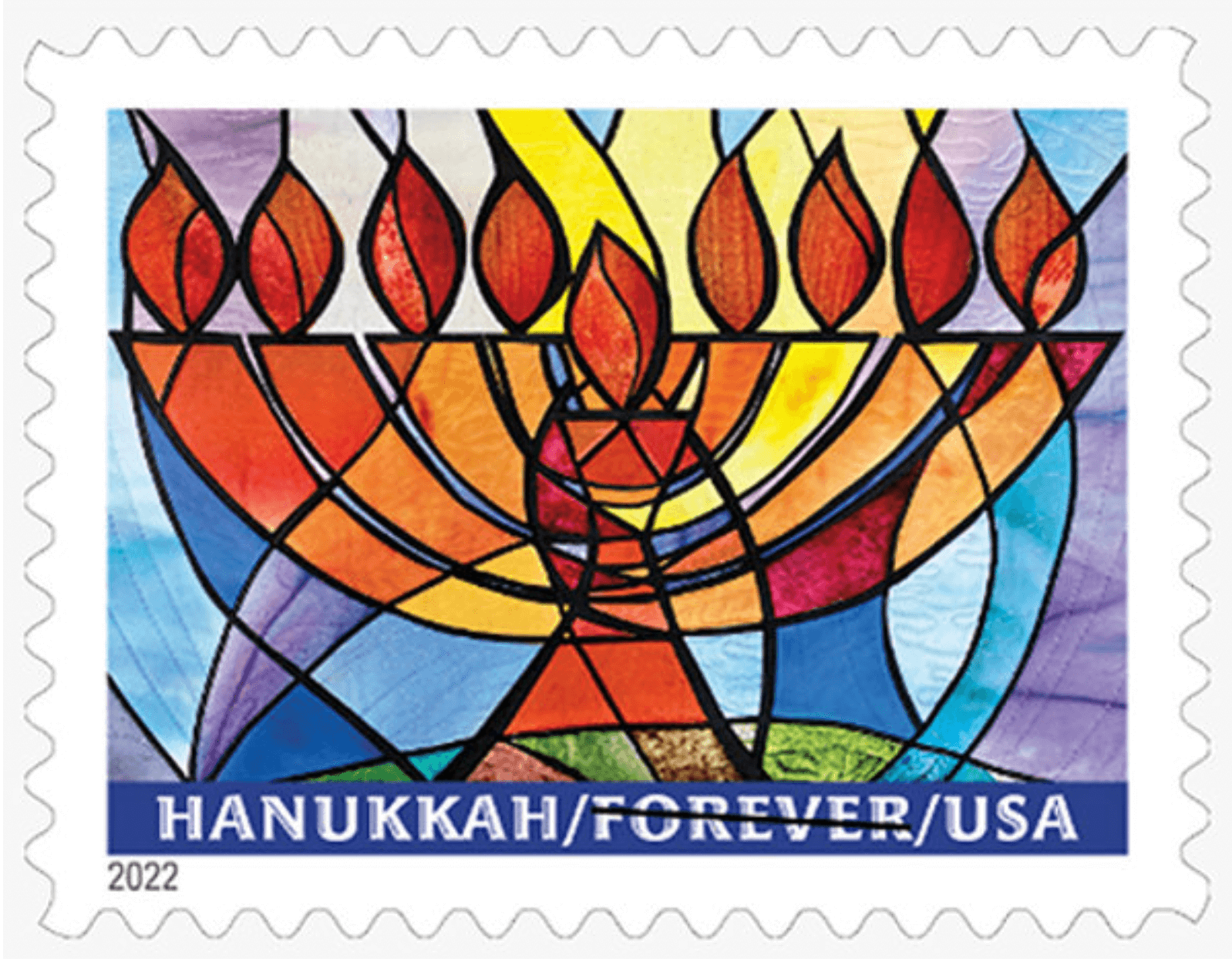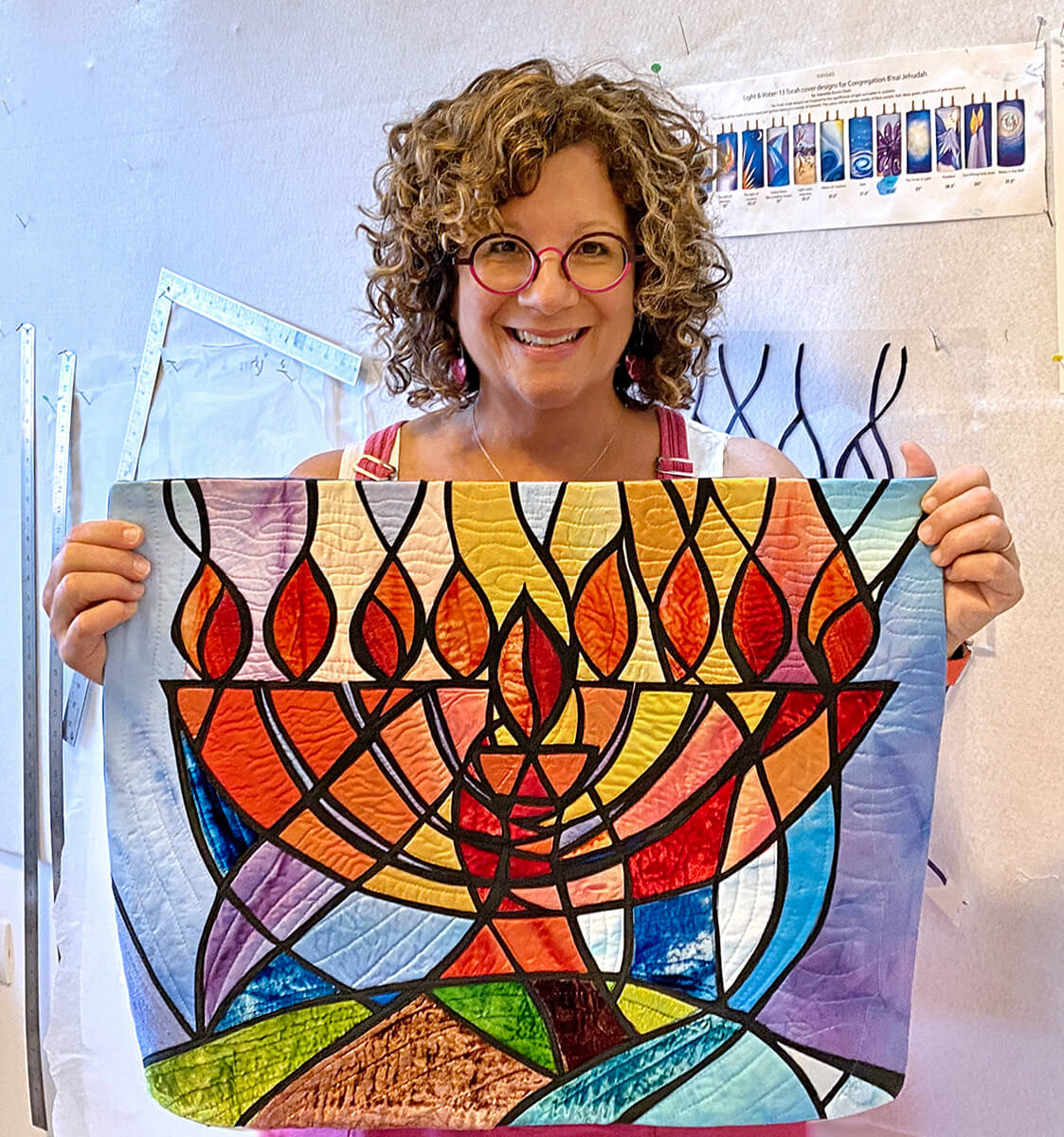Meet the artist behind the new Hanukkah postage stamp
Jeanette Kuvin Oren drew from Jewish traditional paper cutting to create a silk artwork for the U.S. Postal Service

Graphic by Angelie Zaslavsky
Despite the fact that one-third of Americans haven’t mailed a handwritten, personal letter in more than five years, the tradition of the holiday card is not only hanging on but flourishing. Millennials love anything bespoke, and e-cards just don’t have the same charm as receiving a letter by snail mail.
This year, there’s a new stamp to adorn your holiday greetings: The U.S. Postal Service is releasing a new Hanukkah stamp, the first since 2020, created from a brightly colored silk wall-hanging by artist Jeanette Kuvin Oren. It even has a launch party, on Oct. 20 at Temple Emanu El outside of Cleveland.
Oren has designed pieces — including Torah covers, arks, and mosaic installations — for hundreds of synagogues and Jewish institutions, but had always dreamed of creating a postage stamp. She Zoomed in from her studio, wearing striking purple and pink glasses, to talk about how it all happened; that conversation, lightly edited and condensed, is below.
I read on your website that you switched from a Ph.D. in epidemiology to being a full-time artist.
I always did art for fun, but I had every intention of going into public health and working in a health department or university. When I was getting married, the Hillel rabbi here at Yale, where I met my husband, encouraged me to make my own ketubah. That led to making other people’s ketubot. That was 37 years ago, and I’ve been doing Jewish art ever since.
I don’t miss epidemiology, but I have to say that during COVID it would’ve been very exciting to be an epidemiologist.
That’s certainly one word for it.
Exactly.
I see that you draw from Jewish paper cutting — can you tell me more about that?
So I do a lot of techniques, I’m always experimenting with different media. One of the first techniques I used was paper cutting. It’s a very accessible art, anyone could do it with an X-acto knife.
But most of my work is fiber art and large installations for synagogues. In the last couple years, I’ve been able to take the paper-cutting idea and reinterpret it with fabric. I combined two of the things I love to do, which is dye and make fabric art, and paper cutting.

The stamp appears to be based on a design you made for a synagogue in Massachusetts.
What happened is that I was commissioned by a synagogue in Medford [Massachusetts] to design ark doors. The design started with a menorah that I made into a wall hanging. Then I photographed that wall hanging and the photograph is used like film on the glass doors, so it looks like stained glass, but it’s not.
That’s been on my website for years. The Postal Service was perusing Jewish art sites, and they really liked that piece. But it wasn’t suitable for Hanukkah. So I remade it for Hanukkah in the same style, but with the nine branches.
Do you find the Postal Service or does the Postal Service find you?
They find you. The funny thing is that when I started out 37 years ago, I always dreamed of doing a stamp design. My grandfather collected stamps, I love the art on stamps. I remember sending a package into the Postal Service, and that was at least 30 years ago.
Of course, nothing came of it, but they found me this time. It feels like a real full-circle moment.
Can you walk me through the process of how this came to life?
The Postal Service has graphic designers — I don’t know, but less than a dozen. A woman named Ethel Kessler was in charge of the Hanukkah stamp this year and she reached out to me.
I made a small wall hanging and sent it to them. It’s about 16-by-24, and it will hang in the U.S. Postal Museum. The Post Office was lovely, they loved the design. Then they take it from there and do the photography and setup of the stamp itself.
It’s a long process — I first spoke with them almost two years ago. The stamps stay in circulation for about five years, and they don’t have a new one every year.
Making the Hanukkah Stamp 2022 from JKO on Vimeo.
I imagine this process has brought you into deeper contact with the world of philately.
Yes! I have learned a lot. I knew about the stamp design being accepted almost a year and a half ago, but I was sworn to secrecy.
I’ve been doing a lot of research to find out what is a first day cover, what does it mean to be at the first day issue ceremony.
Do tell.
The Postal Service makes a big deal about each new design, and they have a ceremony for every new stamp. So my husband and I are going to drive to Cleveland and be part of the ceremony and I’m really excited about it.
I learned that stamp collectors mostly collect first day covers. It’s usually the size of a small envelope that has the new stamp in the right corner and gets the stamp canceled by the Postal Service on the date of the first day. So in this case, it’s Oct. 20, 2022. And then the location, so it will say the name of the town, which is Chagrin Falls, Ohio.
In addition, the first day cover has a little illustration on it. And it’s usually made by the artist or by a stamp dealer. I learned that America is the only country that doesn’t provide first day covers, it’s done privately. So people asked if I’m going to make a first day cover, and I am! I am going to have a little illustration on the cover of this regulation-size small envelope. And I’ll be hand-painting a little bit of paint on every one, and autographing them, and bringing them back from Cleveland.
Do you hope to make more stamps? What sorts of subjects?
I would love to. On everything! I have 37 years of work I would love to share with the stamp world. All of my work has been Judaic art — not that I don’t want to do other art, but I just don’t have time.

















